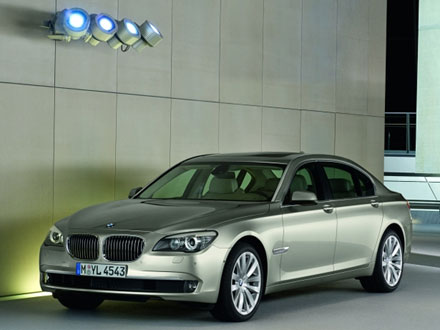
BMW7
Following its successful introduction into the market, the new BMW 7 Series is further expanding its position in 2010 as the most innovative model series in the luxury segment. New drivetrain and equipment variants emphasise both the driving pleasure and the outstanding efficiency of BMW’s top-class luxury saloon.
The BMW 740d to be introduced in autumn, for example, will for the first time feature a new straight-six diesel engine with BMW TwinPower Turbo Technology and maximum output of 225 kW/306 hp. The second diesel model in the range, the BMW 730d, underlines its status as the world’s most economical and lowest emission model in the luxury class by a further reduction in both fuel consumption and CO2 emissions as well as optionally available BMW BluePerformance Technology. Hence, BMW now offers yet another production model already fulfilling the EU6 emission standard today.
These innovations in the BMW 7 Series model range ensure truly thrilling diversity in the prestigious luxury segment. Including the new top-of-the-range BMW 760i and BMW 760Li with their twelve-cylinder power units, the BMW 7 Series is now available in three gasoline and two diesel variants.
BMW’s intelligent xDrive all-wheel drive will also be introduced in the BMW 7 Series for the first time in the 2010 model year, yet another new feature entering the market in autumn 2009 being the M Sports Package available on all models in the BMW 7 Series.
The new diesel model in the BMW 7 Series is characterised by spontaneous and supreme traction and pulling power combined with outstanding efficiency. The BMW 740d features a newly developed six-cylinder power unit, an all-aluminium engine boasting BMW TwinPower Turbo Technology and common-rail direct fuel injection with piezo-injectors operating at an injection pressure of up to 2,000 bar.
The charge system follows the Variable Twin Turbo principle and is made up of two turbochargers of various size perfectly matched to one another and therefore operating either individually or together as a team, depending on the driver’s power and performance requirements. High-pressure fuel injection ensures particularly precise dosage of fuel optimising both the car’s efficiency and the emissions coming from the engine.
The new power unit delivers maximum output of 225 kW/306 hp and peak torque of 600 Newton-metres/442 lb-ft maintained consistently between 1,500 and 2,500 rpm. This gives the BMW 740d a level of performance so far only provided by far larger power units, now combined with the superior economy typical of a BMW straight-six diesel.
The BMW 740d accelerates from a standstill to 100 km/h in 6.3 seconds and is limited electronically in its top speed to 250 km/h or 155 mph.
Average fuel consumption of 6.9 litres/100 kilometres in the EU test cycle (equal to 40.9 mpg imp) and a CO2 emission rating of 181 grams per kilometre, finally, mark new records for efficiency in this performance class.
BMW BluePerformance making ongoing: BMW 730d fulfils the EU6 emission standard.
The cutting-edge diesel engines in the current range allow BMW to introduce further models already fulfilling the future EU6 emission standard today. BMW is therefore consistently increasing its leadership in the introduction of exhaust emission management technology able to fulfil this strictest European standard planned for the future.
The introduction of BMW BluePerformance Technology has no influence on the fuel consumption and CO2 emissions of the BMW 730d, which are in-deed being further reduced once again in the 2010 model year. Modifications on the engine and the drivetrain reduce the average fuel consumption of the BMW 730d determined in the EU test cycle to 6.8 litres/100 kilometres (equal to 41.5 mpg imp), with the CO2 emission rating moving down to 178 grams per kilometre. As a result the BMW 730d is further expanding its leading position as the most efficient saloon in the luxury segment.
Like all other model variants, the BMW 730d owes its outstanding efficiency to superior engine technology as well as the powerful impact of BMW EfficientDynamics naturally featured as standard. Just how fuel-efficient a vehicle may be in the use of energy the driver of a BMW 7 Series will see in future not only on the fuel gauge, since the instrument cluster will be supplemented as of the 2010 model year by a recuperation indicator.
A graphic display next to the current fuel consumption indicator in the lower half of the rev counter presents the generation of electric power in overrun and while applying the brakes, the blue arrow being activated as soon as Brake Energy Regeneration feeds energy into the on-board network without any fuel being consumed in the process.
